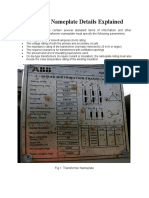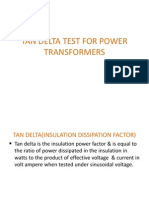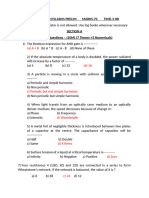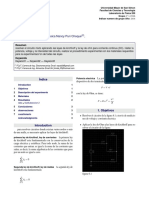Transformer Testing - Type Test and Routine Test of Transformer
Uploaded by
Prabhakar RamachandranTransformer Testing - Type Test and Routine Test of Transformer
Uploaded by
Prabhakar RamachandranTransformer Testing | Type Test and Routine Test of Transformer
For confirming the specifications and performances of an electrical transformer it has to go through numbers of testing procedures. Some tests are done at manufacturer premises before delivering the transformer. Mainly two types of transformer testing are done at manufacturer premises type test of transformer and routine test of transformer. In addition to that some transformer tests are also carried out at the consumer site before commissioning and also periodically in regular & emergency basis through out its service life.
Type of transformer testing
Tests done at Factory Type Tests Routine Tests Special Tests Tests done at Site Pre Commissioning Tests Periodic/Condition Monitoring Tests Emergency Tests
Type test of transformer
To prove that the transformer meets customers specifications and design expectations, the transformer has to go through different testing procedures in manufacturer premises. Some transformer tests are carried out for confirming the basic design expectation of that transformer. These tests are done mainly in a prototype unit not in all manufactured units in a lot. Type test of transformer confirms main and basic design criteria of a production lot.
Routine tests of transformer
Routine tests of transformer is mainly for confirming operational performance of individual unit in a production lot. Routine tests are carried out on every unit manufactured.
Special tests of transformer
Special tests of transformer is done as per customer requirement to obtain information useful to the user during operation or maintenance of the transformer.
Pre commissioning test of transformer
In addition to these, the transformer also goes through some other tests, performed on it, before actual commissioning of the transformer at site. The transformer testing performed before commissioning the transformer at site is called pre commissioning test
of transformer. These tests are done to assess the condition of transformer after installation and compare the test results of all the low voltage tests with the factory test reports. Type tests of transformer includes Transformer winding resistance measurement Transformer ratio test Transformer vector group test Measurement of impedance voltage/short circuit impedance (principal tap) and load loss (Short circuit test) Measurement of no load loss and current (Open circuit test) Measurement of insulation resistance Dielectric tests of transformer Temperature rise test of Transformer Tests on on-load tap-changer Vacuum tests on tank and radiators Routine tests of transformer include Transformer winding resistance measurement Transformer ratio test Transformer vector group test Measurement of impedance voltage/short circuit impedance (principal tap) and load loss (Short circuit test) Measurement of no load loss and current (Open circuit test) Measurement of insulation resistance Dielectric tests of transformer Tests on on-load tap-changer Oil pressure test on transformer to check against leakages past joints and gaskets. That means Routine tests of transformer include all the type tests except temperature rise and vacuum tests. The oil pressure test on transformer to check against leakages past joints and gaskets is included. Special Tests of transformer include Dielectric Tests Measurement of zero-sequence impedance of three-phase transformers Short-Circuit Test Measurement of acoustic noise level Measurement of the harmonics of the no-load current Measurement of the power taken by the fans and oil pumps Tests on bought out components / accessories such as buchhloz relay, temperature indicators, pressure relief devices, oil preservation system etc.
Transformer winding resistance measurement
Transformer winding resistance measurement is carried out to calculate the I2R losses and to calculate winding temperature at the end of a temperature rise test. It is carried out as a type test as well as routine test. It is also done at site to ensure healthiness of a transformer that is to check loose connections, broken strands of conductor, high contact resistance in tap changers, high voltage leads and bushings etc.
There are different methods for measuring of transformer winding, likewise Current voltage method of measurement of winding resistance. Bridge method of measurement of winding resistance. Kelvin bridge method of Measuring Winding Resistance. Measuring winding resistance by Automatic Winding Resistance Measurement Kit. NB: Transformer winding resistance measurement shall be carried out at each tap.
Transformer Ratio Test
The performance of a transformer largely depends upon perfection of specific turns or voltage ratio of transformer. So transformer ratio test is an essential type test of transformer. This test also performed as routine test of transformer. So for ensuring proper performance of electrical power transformer, voltage and turn ratio test of transformer one of the vital tests. The procedure of transformer ratio test is simple. We just apply three phase 415 V supply to HV winding, with keeping LV winding open. The we measure the induced voltages at HV and LV terminals of transformer to find out actual voltage ratio of transformer. We repeat the test for all tap position separately.
Magnetic balance test of transformer
Magnetic balance test of transformer is conducted only on three phase transformers to check the imbalance in the magnetic circuit.
Procedure of Magnetic balance test of transformer
1) First keep the tap changer of transformer in normal position. 2) Now disconnect the transformer neutral from ground. 3) Then apply single phase 230V AC supply across one of the HV winding terminals and neutral terminal. 4) Measure the voltage in two other HV terminals in respect of neutral terminal. 5) Repeat the test for each of the three phases. In case of auto transformer, magnetic balance test of transformer should be repeated for IV winding also. There are three limbs side by side in a core of transformer. One phase winding is wound in one limb. The voltage induced in different phases depends upon the respective position of the limb in the core. The voltage induced in different phases of transformer in respect to neutral terminals given in the table below.
Voltage applied at left
Left side phase AN 230 V
Central phase BN 180 V
Right side phase CN 50 V
side phase Voltage applied at central phase Voltage applied at right side phase
115 V 50 V
230 V 180 V
115 V 230 V
Magnetizing Current Test of Transformer
Magnetizing current test of transformer is performed to locate defects in the magnetic core structure, shifting of windings, failure in turn to turn insulation or problem in tap changers. These conditions change the effective reluctance of the magnetic circuit, thus affecting the electric current required to establish flux in the core. 1) First of all keep the tap changer in the lowest position and open all IV & LV terminals. 2) Then apply three phase 415V supply on the line terminals for three phase transformers and single phase 230V supply on single phase transformers. 3) Measure the supply voltage and electric current in each phase. 4) Now repeat the magnetizing current test of transformertest with keeping tap changer in normal position. 5) And repeat the test with keeping the tap at highest position. Generally there are two similar higher readings on two outer limb phases on transformer core and one lower reading on the centre limb phase, in case of three phase transformers. An agreement to within 30 % of the measured exciting current with the previous test is usually considered satisfactory. If the measured exciting current value is 50 times higher than the value measured during factory test, there is likelihood of a fault in the winding which needs further analysis. Caution: This magnetizing current test of transformer is to be carried out before DC resistance measurement.
Vector Group Test of Transformer
In three phase transformer, it is essential to carry out a vector group test of transformer. Proper vector grouping in a transformer is an essential criteria for parallel operation of transformers. There are several internal connection of three phase transformer are available in market. These several connections gives various magnitudes and phase of the secondary voltage; the magnitude can be adjusted for parallel operation by suitable choice of turn ratio, but the phase divergence can not be compensated. So we have to choose those transformer for parallel operation whose phase sequence and phase divergence are same. All the transformers with same vector ground have same phase sequence and phase divergence between primary and secondary. So before procuring one electrical power transformer, one should ensure the vector group of the transformer, whether it will be matched with his or her existing system or not. The vector group test of transformer confirms his or her requirements.
Insulation Resistance Test or Megger Test of transformer
Insulation resistance test of transformer is essential type test. This test is carried out to ensure the healthiness of over all insulation system of an electrical power transformer.
Procedure of Insulation Resistance test of transformer
1) First disconnect all the line and neutral terminals of the transformer. 2) Megger leads to be connected to LV and HV bushing studs to measure Insulation Resistance IR value in between the LV and HV windings. 3) Megger leads to be connected to HV bushing studs and transformer tank earth point to measure Insulation Resistance IR value in between the HV windings and earth. 4) Megger leads to be connected to LV bushing studs and transformer tank earth point to measure Insulation Resistance IR value in between the LV windings and earth. NB : It is unnecessary to perform insulation resistance test of transformer per phase wise in three phase transformer. IR values are taken between the windings collectively as because all the windings on HV side are internally connected together to form either star or delta and also all the windings on LV side are internally connected together to form either star or delta. Measurements are to be taken as follows: For Auto Transformer: HV-IV to LV, HV-IV to E, LV to E For Two Winding Transformer: HV to LV, HV to E, LV to E Three Winding Transformer: HV to IV, HV to LV, IV to LV, HV to E, IV to E, LV to E Oil temperature should be noted at the time of insulation resistance test of transformer. Since the IR value of transformer insulating oil may vary with temperature. IR values to be recorded at intervals of 15 seconds, 1 minute and 10 minutes. . With the duration of application of voltage, IR value increases. The increase in IR is an indication of dryness of insulation. Absorption Coefficient = 1 minute value/ 15 secs. value. Polarization Index = 10 minutes value / 1 minute value
Dielectric Tests of Transformer
Dielectric tests of transformer is one kind of insulation test. This test is performed to ensure the expected over all insulation strength of transformer. There are several test
performed to ensure the required quality of transformer insulation, dielectric test is one of them. Dielectric tests of transformer is performed in two different steps, first one called Separate source voltage withstand test of transformer, where a single phase power frequency voltage of prescribed level, is applied on transformer winding under test for 60 seconds while the other windings and tank are connected to the earth and it is observed that whether any failure of insulation occurs or not during the test. Second one is induced voltage test of Transformer where, three phase voltage, twice of rated secondary voltage is applied to the secondary winding for 60 second by keeping the primary of the transformer open circuited. The frequency of the applied voltage should be double of power frequency too. Here also if no failure of insulation, the test is successful. In addition to Dielectric tests of transformer there are other type test for checking insulation of transformer, such as lightning impulse test, switching impulse test and partial discharge test.
Induced voltage test of Transformer
The induced voltage test of transformer is intended to check the inter turn and line end insulation as well as main insulation to earth and between windings 1) Keep the primary winding of transformer open circuited. 2) Apply three phase voltage to the secondary winding. The applied voltage should be twice of rated voltage of secondary winding in magnitude and frequency. 3) The duration of the test shall be 60 second. 4) The test shall start with a voltage lower than 1/3 the full test voltage, and it shall be quickly increased up to desired value. The test is successful if no break down occurs at full test voltage during test.
Temperature Rise Test of Transformer
Temperature rise test of Transformer is included in type test of transformer. In this test we check whether the temperature rising limit of the transformer winding and oil as per specification or not. In this type test of transformer, we have to check oil temperature rise as well as winding temperature rise limits of an electrical transformer. ------------------------------ x -----------------------------------x----------------------------
Transformer Winding Resistance Measurement
Transformer winding resistance measurement is carried out as a type test, routine test and also as a field test. In the factory, it helps in determining the following : (a) Calculation of the I2R losses in transformer (b) Calculation of winding temperature at the end of temperature rise test of transformer. (c) As a benchmark for assessing possible damages in the field. It is done at site in order to check for abnormalities due to loose connections, broken strands of conductor, high contact resistance in tap changers, high voltage leads and bushings.
Procedure of Transformer winding resistance measurement
For star connected winding, the resistance shall be measured between the line and neutral terminal. For star connected auto-transformers the resistance of the HV side is measured between HV terminal and IV terminal, then between IV terminal and the neutral. For delta connected windings, measurement of winding resistance shall be done between pairs of line terminals. As in delta connection the resistance of individual winding can not be measured separately, the resistance per winding shall be calculated as per the following formula: Resistance per winding = 1.5 x Measured value The resistance is measured at ambient temperature and then converted to resistance at 75C for all practical purposes of comparison with specified design values, previous results and diagnostics. Winding Resistance at standard temperature of 75oC
Rt = Winding resistance at temperature t. t = Winding temperature Generally transformer windings are immersed in insulation liquid and covered with paper insulation, hence it is impossible to measure the actual winding temperature in a deenergizing transformer at time of transformer winding resistance measurement. An approximation is developed to calculate temperature of winding at that condition, as follows Temperature of winding = Average temperature of insulating oil. (Average temperature of insulating oil should be taken 3 to 8 hours after de-energizing transformer and when the difference between top & bottom oil temperatures becomes less than 5oC) The resistance can be measured by simple voltmeter ammeter method, Kelvin Bridge meter or automatic winding resistance measurement kit (ohm meter, preferably 25
Amps kit) Caution for voltmeter ammeter method: Current shall not exceed 15% of the rated current of the winding. Large values may cause inaccuracy by heating the winding and thereby changing its temperature and resistance. NB: Measurement of winding resistance of transformer shall be carried out at each tap.
Current Voltage Method of measurement of winding resistance
The transformer winding resistances can be measured by current voltage method. In this method of measurement of winding resistance, the test current is injected to the winding and corresponding voltage drop across the winding is measured. By applying simple Ohms law i.e. Rx = V I, one can easily determine the value of resistance.
Procedure of current voltage method of measurement of winding resistance
1) Before measurement the transformer should be kept in OFF condition without excitation at least for 3 to 4 hours. During this time the winding temperature will become equal to its oil temperature. 2) Measurement is done with D.C. 3) To minimize observation errors, polarity of the core magnetization shall be kept constant during all resistance readings. 4) Voltmeter leads shall be independent of the current leads to protect it from high voltages which may occur during switching on and off the current circuit. 5) The readings shall be taken after the electric current and voltage have reached steady state values. In some cases this may take several minutes depending upon the winding impedance. 6) The test current shall not exceed 15% of the rated current of the winding. Large values may cause inaccuracy by heating the winding and thereby changing its resistance. 7) For expressing resistance, the corresponding temperature of the winding at the time of measurement must be mentioned along with resistance value. As we said earlier that after remaining in switch off condition for 3 to 4 hours, the winding temperature would become equal to oil temperature. The oil temperature at the time of testing is taken as
the average of top oil and bottom oil temperatures of transformer.
8) For star connected three phase winding, the resistance per phase would be half of measured resistance between two line terminals of the transformer. 9) For delta connected three phase winding, the resistance per phase would be 0.67 times of measured resistance between two line terminals of the transformer. 10) This current voltage method of measurement of winding resistance of transformer should be repeated for each pair of line terminals of winding at every tap position.
Bridge Method of measurement of winding resistance
The main principle of bridge method is based on comparing an unknown resistance with a known resistance. When electric currents flowing through the arms of bridge circuit become balanced, the reading of galvanometer shows zero deflection that means at balanced condition no electric current will flow through the galvanometer. Very small value of resistance ( in milli ohms range) can be accurately measured by Kelvin Bridge method whereas for higher value Wheatstone bridge method of resistance measurement is applied. In bridge method of measurement of winding resistance, the errors is minimized.
The resistance measured by Kelvin Bridge;
All other steps to be taken during transformer winding resistance measurement in these methods are similar to that of current voltage method of measurement of winding resistance of transformer, except the measuring technique of resistance.
The resistance measured by Wheatstone Bridge;
------------------------------ x
------------------------------------
x----------------------------
Voltage and Turn Ratio Test of Transformer
The performance of a transformer largely depends upon perfection of specific turns or voltage ratio of transformer. So transformer ration test is an essential type test of transformer. The voltage should be applied only in the high voltage winding in order to avoid unsafe voltage.
Ratio test of transformer and check of phase displacement
Actually the no load voltage ratio of transformer is equal to the turn ratio. So ratio test of transformer
Procedure of transformer ration test
1) First, the tap changer of transformer is kept in the lowest position and LV terminals are kept open. 2) Then apply 3-phase 415 V supply on HV terminals. Measure the voltages applied on
each phase (Phase-Phase) on HV and induced voltages at LV terminals simultaneously. 3) After measuring the voltages at HV and LV terminals, the tap changer of transformer should be raised by one position and repeat test. 4) Repeat the same for each of the tap position separately. The above transformer ratio test can also be performed by portable Transformer Turns Ratio (TTR) Meter. They have an in built power supply, with the voltages commonly used being very low, such as 8-10 V and 50 Hz. The HV and LV windings of one phase of a transformer are connected to the instrument, and the internal bridge elements are varied to produce a null indication on the detector. Lets have a discussion on Transformer Turns Ratio (TTR) Meter method of turn ratio test of transformer A phase voltage is applied to the one of the windings by means of a bridge circuit and the ratio of induced voltage is measured at the bridge. The accuracy of the measuring instrument is < 0.1 %
This theoretical turn ratio is adjusted on the transformer turn ratio tested or TTR by the adjustable transformer as shown in the figure above and it should be changed until a balance occurs in the percentage error indicator. The reading on this indicator implies the deviaton of measured turn ratio from expected turn ratio in percentage.
Out-of-tolerance, ratio test of transformer can be due to shorted turns, especially if there is an associated high excitation current. Open turns in HV winding will indicate very low exciting current and no output voltage since open turns in HV winding causes no excitation current in the winding means no flux hence no induced voltage. But open turn in LV winding causes, low fluctuating LV voltage but normal excitation current in HV winding. Hence open turns in LV winding will be indicated by normal levels of exciting current, but very low levels of unstable output voltage. The turn ratio test of transformer also detects high resistance connections in the lead circuitry or high contact resistance in tap changers by higher excitation current and a difficulty in balancing the bridge. ------------------------------ x -----------------------------------x----------------------------
Insulation Dielectric Test of Transformer
The dielectric test of transformer is generally performed in two different steps, likewise, separate source voltage withstand test and induced voltage withstand test of transformer, which we have discussed one by one below.
Separate source voltage withstand test of transformer
This dielectric test is intended to check the the ability of main insulation to earth and between winding.
Procedure
1) All three line terminals of the winding to be tested are connected together. 2) Other winding terminals which are not under test and also tank of the transformer should be connected to earth. 3) Then a single-phase power frequency voltage of shape approximately sinusoidal is applied for 60 seconds to the terminals of the winding under test. 4) The test shall be performed on all the windings one by one. 6) The test is successful if no break down in the dielectric of the insulation occurs during test.
In this transformer testing, the peak value of voltage is measured, that is why the capacitor voltage divider with digital peak voltmeter is employed as shown in the diagram above. The peal value multiplied by 0.707 (1/2) is the test voltage. The values of test voltage for different fully insulated winding are furnished below in the table. Highest Rated short duration Nominal system system power frequency voltage rating voltage rating withstand for equipment for equipment voltage 415V 1.1 KV 3 KV 11 KV 12 KV 28 KV 33 KV 36 KV 70 KV 132 KV 145 KV 230 / 275 KV 220 KV 245 KV 360 / 395 KV 400 KV 420 KV 570 / 630 KV Winding with graded insulation, which has neutral intended for direct earthing, is tested at 38KV
Induced voltage test of Transformer
The induced voltage test of transformer is intended to check the inter turn and line end insulation as well as main insulation to earth and between windings 1) Keep the primary winding of transformer open circuited. 2) Apply three phase voltage to the secondary winding. The applied voltage should be twice of rated voltage of secondary winding in magnitude and frequency. 3) The duration of the test shall be 60 second. 4) The test shall start with a voltage lower than 1/3 the full test voltage, and it shall be quickly increased up to desired value. The test is successful if no break down occurs at full test voltage during test.
------------------------------ x ------------------------------ x ------------------------------ x
----------------------------------------------------------------------------------------------------------
x---------------------------x---------------------------x----------------------------
You might also like
- Tan Delta Test - Loss Angle Test - Dissipation Factor Test100% (1)Tan Delta Test - Loss Angle Test - Dissipation Factor Test2 pages
- Transformer Testing - Type Test and Routine Test of Transformer80% (5)Transformer Testing - Type Test and Routine Test of Transformer48 pages
- Transformer Testing - Type Test and Routine Test of Transformer - Electrical100% (2)Transformer Testing - Type Test and Routine Test of Transformer - Electrical15 pages
- Science 7 Lesson Plan Anatomy of A Wave (Unit 3, Module 2)50% (2)Science 7 Lesson Plan Anatomy of A Wave (Unit 3, Module 2)5 pages
- Transformer Testing: Type Test of Transformer100% (3)Transformer Testing: Type Test of Transformer9 pages
- Testing Tap Changers: by Michael Krüger, OMICRON Electronics AustriaNo ratings yetTesting Tap Changers: by Michael Krüger, OMICRON Electronics Austria2 pages
- Alfanar Co.: Site Test Report Ng-Sa Name of Substation: Dammam Housing 115/13.8KV Substation # 3 Aux - Relay (Rxmb1) Test100% (1)Alfanar Co.: Site Test Report Ng-Sa Name of Substation: Dammam Housing 115/13.8KV Substation # 3 Aux - Relay (Rxmb1) Test2 pages
- Transformer Test: Prepared By: Nishant AcharyaNo ratings yetTransformer Test: Prepared By: Nishant Acharya30 pages
- Testing of Transformers: T.R.Sathyanarayana Rao100% (4)Testing of Transformers: T.R.Sathyanarayana Rao24 pages
- Pre-Commissioning Test Report of TransformerNo ratings yetPre-Commissioning Test Report of Transformer2 pages
- Testing of Transformer: by - Geetesh Verma100% (1)Testing of Transformer: by - Geetesh Verma21 pages
- University of Turkish Aeronautical Association Faculty of Engineering EEE DepartmentNo ratings yetUniversity of Turkish Aeronautical Association Faculty of Engineering EEE Department57 pages
- Power Transformer Testing Proceduer Update50% (2)Power Transformer Testing Proceduer Update102 pages
- Testing and Commissioning of Current Transformer PDF100% (1)Testing and Commissioning of Current Transformer PDF15 pages
- Insulation Resistance of Power Transformer100% (3)Insulation Resistance of Power Transformer16 pages
- Transformer Testing - Type Tests and Routine Tests of TransformerNo ratings yetTransformer Testing - Type Tests and Routine Tests of Transformer8 pages
- Transformer Testing - Type Tests and Routine Tests of TransformerNo ratings yetTransformer Testing - Type Tests and Routine Tests of Transformer10 pages
- Transformer Testing Type Test and Routine Test of TransformerNo ratings yetTransformer Testing Type Test and Routine Test of Transformer9 pages
- Type of Transformer Testing: Tests Done at FactoryNo ratings yetType of Transformer Testing: Tests Done at Factory6 pages
- Weekly Down Time Report 11-04-16 Up To 17-04-16No ratings yetWeekly Down Time Report 11-04-16 Up To 17-04-163 pages
- 10-A 4 1 Unequal Wilkinson Power DividerNo ratings yet10-A 4 1 Unequal Wilkinson Power Divider3 pages
- Ordered Pair:-An Ordered Pair Consist of Two Elements in A Fixed OrderNo ratings yetOrdered Pair:-An Ordered Pair Consist of Two Elements in A Fixed Order19 pages
- Art and Science of Acoustic Diffusers by Ines AlbramNo ratings yetArt and Science of Acoustic Diffusers by Ines Albram2 pages
- Wireless Telephony - Fessenden (1908) PDFNo ratings yetWireless Telephony - Fessenden (1908) PDF52 pages
- Instant Download Problems and Solutions in Quantum Mechanics 1st Edition Kyriakos Tamvakis PDF All Chapter100% (9)Instant Download Problems and Solutions in Quantum Mechanics 1st Edition Kyriakos Tamvakis PDF All Chapter70 pages
- Variational Iteration Method For Vibration ProblemsNo ratings yetVariational Iteration Method For Vibration Problems32 pages
- Ley de Kirchhoff: Eddy Gutierrez Ayala, Yessica Nancy Puri ChoqueNo ratings yetLey de Kirchhoff: Eddy Gutierrez Ayala, Yessica Nancy Puri Choque3 pages
- Tan Delta Test - Loss Angle Test - Dissipation Factor TestTan Delta Test - Loss Angle Test - Dissipation Factor Test
- Transformer Testing - Type Test and Routine Test of TransformerTransformer Testing - Type Test and Routine Test of Transformer
- Transformer Testing - Type Test and Routine Test of Transformer - ElectricalTransformer Testing - Type Test and Routine Test of Transformer - Electrical
- Science 7 Lesson Plan Anatomy of A Wave (Unit 3, Module 2)Science 7 Lesson Plan Anatomy of A Wave (Unit 3, Module 2)
- Testing Tap Changers: by Michael Krüger, OMICRON Electronics AustriaTesting Tap Changers: by Michael Krüger, OMICRON Electronics Austria
- Alfanar Co.: Site Test Report Ng-Sa Name of Substation: Dammam Housing 115/13.8KV Substation # 3 Aux - Relay (Rxmb1) TestAlfanar Co.: Site Test Report Ng-Sa Name of Substation: Dammam Housing 115/13.8KV Substation # 3 Aux - Relay (Rxmb1) Test
- University of Turkish Aeronautical Association Faculty of Engineering EEE DepartmentUniversity of Turkish Aeronautical Association Faculty of Engineering EEE Department
- Testing and Commissioning of Current Transformer PDFTesting and Commissioning of Current Transformer PDF
- Transformer Testing - Type Tests and Routine Tests of TransformerTransformer Testing - Type Tests and Routine Tests of Transformer
- Transformer Testing - Type Tests and Routine Tests of TransformerTransformer Testing - Type Tests and Routine Tests of Transformer
- Transformer Testing Type Test and Routine Test of TransformerTransformer Testing Type Test and Routine Test of Transformer
- Type of Transformer Testing: Tests Done at FactoryType of Transformer Testing: Tests Done at Factory
- Ordered Pair:-An Ordered Pair Consist of Two Elements in A Fixed OrderOrdered Pair:-An Ordered Pair Consist of Two Elements in A Fixed Order
- Art and Science of Acoustic Diffusers by Ines AlbramArt and Science of Acoustic Diffusers by Ines Albram
- Instant Download Problems and Solutions in Quantum Mechanics 1st Edition Kyriakos Tamvakis PDF All ChapterInstant Download Problems and Solutions in Quantum Mechanics 1st Edition Kyriakos Tamvakis PDF All Chapter
- Variational Iteration Method For Vibration ProblemsVariational Iteration Method For Vibration Problems
- Ley de Kirchhoff: Eddy Gutierrez Ayala, Yessica Nancy Puri ChoqueLey de Kirchhoff: Eddy Gutierrez Ayala, Yessica Nancy Puri Choque

























































































